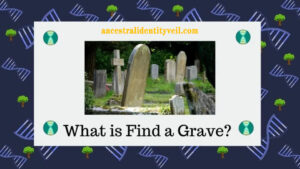Are you curious about Find a Grave? In this post, you will learn what it is, where its information originates, and how you can utilize it in your family tree research.
Find-a-Grave is an extremely useful and engaging website that should be in every genealogist or family tree researcher’s toolbox. By gathering more information from this source, Find-a-Grave allows us to learn about where our ancestors may have lived their lives, who they had as family members, etc.

Find-a-Grave has been invaluable in my genealogy research, helping me locate burial locations of some of my more recently deceased ancestors as well as gathering details about more distant relatives through memorials and gravestones.
Find-a-Grave provides us with opportunities to give back and contribute to the greater genealogical community. We can do this by taking photos of cemeteries or grave sites, leaving digital flowers for ancestors whom we would like to remember, or providing information that will enable future researchers to connect ancestors with their families.
Are You Wondering If Find a Grave is Legitimate?
Yes, Find a Grave is an official website offering details regarding grave sites and cemeteries across the U.S. as well as photographs and biographical details about those who have passed on.
Find-a-Grave also allows users to search obituaries, additional details provided by those creating memorials on Find-a-Grave, and photographs taken of cemetery and gravestone of an individual; something most of us would find difficult or impossible to do ourselves.
Are we sure Find-a-Grave is free? Since its creation, Find-a-Grave has always been available free of charge; as of 2023 it remains free for anyone to access and utilize the site to locate memorials, search cemeteries for graves and become contributors on its database.
Find-a-Grave was first founded by Jim Tiptop in 1995 as an archive for recording grave sites of well-known people. While this remains its purpose today, Find-a-Grave quickly expanded beyond this scope and now serves as an indispensable tool for family tree research.
As I type this piece, it dawned on me that Find-a-Grave must be one of the oldest websites still online. What’s remarkable is its staying power after its ownership transfer to Ancestry.com and several site redesigns; still free and not digressing too far from its initial mission statement.
How Does Find-a-Grave Get Information? Find-a-Grave is powered by millions of users and members who contribute their information voluntarily over more than two decades, making up its resourcefulness.
Find-a-Grave is driven by members and volunteer contributors, so memorial details should always be viewed as “clues”. This means memorials on Find-a-Grave don’t serve as solid genealogical evidence themselves but instead provide us with pointers as to where documents that could serve as such evidence can be found.
If we find an ancestor memorial that provides information about when and where they were born, such as when and where their death took place, we can look for vital records in that city or state to verify the information contained on their Find-a-Grave memorial. A good quality picture of their tombstone could also serve as secondary proof.
How Can You Use Find-a-Grave? Find-a-Grave is an extremely simple way to search for memorials or cemeteries online, directly from its homepage (which currently resembles this image).
Simply provide as much information about your ancestor as you know and press the “Search” button.
Your search can be as broad or specific as necessary; more specific knowledge will lead to better results.
Searching Rhode Island burial records would yield over 3,000 matching results containing the name Clark.
Results for Clark in Rhode Island produce 3,397 matches – that’s quite an intimidating number of results to look through!
If you know more details about your ancestor you are searching for, such as their name, year of death or even cemetery location (for instance when searching for all “Clarks” with memorial sites in Providence County Rhode Island: as a result). Below is what happened when I searched.
Find what you are searching for more quickly by narrowing your results with more specific queries. This can often produce quicker results that lead to what you need more quickly.
As evidenced above, it’s easier to search four matching records than more than 3000. While specificity can sometimes yield fruitful results, if that fails then perhaps broader search options might provide better solutions.
Find a Grave does not require registration in order to search the site, however if you would like to contribute in any way – including leaving digital flowers at memorials – an account must be created free of charge.
On the Find-a-Grave homepage is a link entitled “Register”. When clicked upon, a pop-up window will open where you can fill in your details to register an account with us and create your user account.
Once you create an account, it’s easy and fast to leave flowers with messages for relatives – which can sometimes be very helpful to other users. Plus, once contributing begins in earnest you may even take on tasks such as transcribing photos or fulfilling photo requests for local cemeteries!
Conclusion
We hope that this post has given you a deeper understanding of Find a Grave and how information ends up on their website, so you can better use it to discover more about your ancestors and explore family histories.
If you have any queries or wish to share any insight that you discovered while researching your family tree on Find a Grave, or want to share something interesting that transpired while doing this post, I welcome hearing about them in the discussion thread below.
Leave a Reply